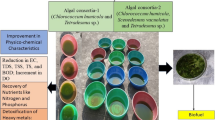Abstract
Three isolates ofSpirulina platensis (Norst) Geitler marked BP, P4P and Z19/2 were compared with respect to their response and acclimation capability to high photon flux densities (HPFD). Cultures exposed to HPFD (1500–3500 μmol photon m−2 s−1) exhibited a marked decrease in light-dependent O2 evolution rate. P4P was more sensitive to HPFD than the two other isolates. All three isolates recovered from photoinhibition when placed under low PFD. The BP isolate was able to recover also in the dark but to a lower extent and at a lower rate, while no recovery was observed in the other two isolates under dark conditions. No recovery was observed when protein synthesis was inhibited using chloramphenicol. Cultures grown at 200 μmol photon m−2 s−1 differed from cultures grown at 120 μmol photon m 2 s-1 by their lower maximal photosynthetic rate (P max ) and higher light saturation (I k ) value, while being more resistant to HPFD stress. The ability ofSpirulina isolates to acclimate and withstand HPFD may provide useful information for the selection of strains useful for outdoor mass cultivation.
Similar content being viewed by others
References
Bennet J, Bogorad L (1973) Complementary chromatic adaptation in a filamentous blue-green alga. J. Cell Biol. 58: 419–435.
Baker NR, Bowyer (eds) (1994) Photoinhibition of Photosynthesis: from Molecular Mechanisms to the Field. Bios Scientific Publishers Ltd, Oxford.
Critchley C (1981) Studies on the mechanism of photoinhibition in higher plants. Plant Physiol. 67: 1161–1165.
Falk S, Samuelsson G (1992) Recovery of photosynthesis and photosystem II fluorescence inChlamydomonas reinhardtii after exposure to three levels of high light. Physiologia Plantarum 85: 61–68.
Greer DH, Berry JA, Bjorkman O (1986) Photoinhibition of photosynthesis in intact bean leaves. Role of light and temperature, and requirement for chloroplast-protein synthesis during recover. Planta (Berl.) 168: 253–260.
Jensen K, Knutsen (1993) Influence of light and temperature on photoinhibition of photosynthesis inSpirulina platensis. J. appl. Phycol. 5: 495–504.
Krupa Z, Öquist G, Gustafsson P (1990) Photoinhibition and recovery of photosynthesis in psbA gene-inactivated strains of cyanobacteriumAnacystis nidulans. Plant Physiol. 93: 1–6.
Neale PJ (1988) Algal photoinhibition and photosynthesis in the aquatic environment. In: Kyle DJ, Osmond CB, Arntzen CJ (eds), Elsevier, Amsterdam: 39–66.
Ohad I, Kyle DJ, Arntzen, CJ (1984) Membrane protein damage and repair removal and replacement of inactivated 32 kD polypeptides in chloroplast membranes. J. Cell Biol. 99: 481–485.
Powles SB (1984) Photoinhibition of photosynthesis induced by visible light. Annu. Rev. Plant Physiol. 35: 15–44.
Richmond A (1987)Spirulina. In Borowitzka M, Borowitzka L (eds) Microalgal Biotechnology. Cambridge University Press, Cambridge: 85–121.
Richter M, Rühle W Wild A (1990) Studies on the mechanism of photosystem II photoinhibition. I. A two step degradation of D1-protein. Photosynthesis 24: 229–235.
Samuelsson G, Lonneborg A, Rosenqvist E, Gustafsson P, Öquist G (1985) Photoinhibition and reactivating of photosynthesis in the cyanobacteriumAnacystis nidulans. Plant Physiol. 79: 992–995.
Samuelsson G, Lonneborg A, Gustafsson P, Öquist G (1987) The susceptibility of photosynthesis to photoinhibition and the capacity of recovery in high and low light grown cyanobacteriaAnacystis nidulans. Plant Physiol. 83: 438–441.
Vonshak A, Abeliovich A, Boussiba S, Richmond A (1982) Production ofSpirulina biomass: effects of environmental factors and population density. Biomass 2: 175–185.
Vonshak A, Guy R (1992) Photoadaptation, photoinhibition and productivity in the blue-green alga,Spirulina platensis grown outdoors. Plant Cell Environ. 15: 613–616.
Vonshak A, Guy R, Poplawsky R, Ohad I (1988) Photoinhibition and its recovery in two strains of the cyanobacteriumSpirulina platensis. Plant Cell Physiol. 29: 721–726.
Vonshak A, Torzillo G, Tomaselli L (1994) Use of chlorophyll fluorescence to estimate the effect of photoinhibition in outdoor culture ofSpirulina platensis. J. appl. Phycol. 6: 31–34.
Author information
Authors and Affiliations
Additional information
Author for correspondence
Rights and permissions
About this article
Cite this article
Vonshak, A., Chanawongse, L., Bunnag, B. et al. Light acclimation and photoinhibition in threeSpirulina platensis (cyanobacteria) isolates. J Appl Phycol 8, 35–40 (1996). https://doi.org/10.1007/BF02186220
Received:
Revised:
Accepted:
Issue Date:
DOI: https://doi.org/10.1007/BF02186220




